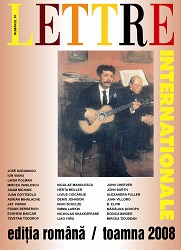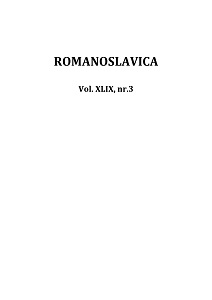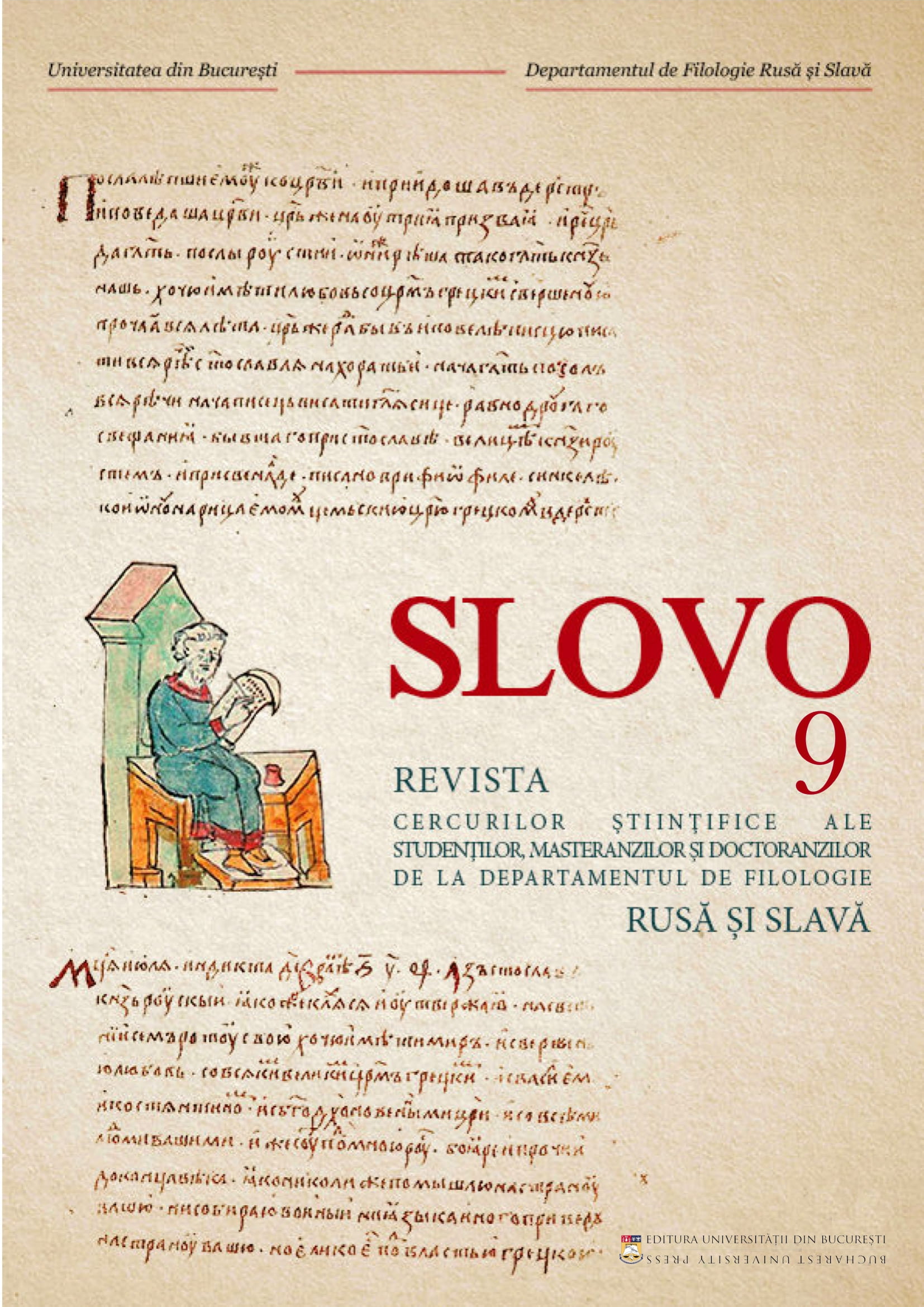Epic Revisionism: Russian History and Literature as Stalinist Propaganda. Edited by Kevin M.F. Platt and David Brandenberger. Wisconsin: The University of Wisconsin Press, 2006. xvi+355 pp.
More...
Keywords: Jay Parini; Tolstoi; Tolstoy;
A fragment from the homonymous novel.
More...
Keywords: Religion;Metaphysics;Transcendence;Cosmism;USSR;Transition;Russia;
Human interests to Religion and Metaphysics are well explained by the desire of the people to answer to fundamental and eternal questions as “what is the sense of life” and “what is the purpose of life”. These questions have accompanied them from the beginning of conscious life. Many intellectuals, scientists and writers of former USSR and democratic Russia have brought essential contributions, opened new directions and finally have enriched with new concepts, ideas, ideologies and systems the worldwide Philosophy and Religion. A possible answer is the Creation allowing to Divinity to transcend in common life. Soul as Spiritual reflection of Divinity tends to perfection, reiterating in every generation the transcendence to God. At first sight there are no meeting points between Transcendence and Cosmism because the last notion has its beginning in the progress of Science. The evolution of modern Sciences, philosophical concepts and Religion gradually demonstrates correlated aspects which must be discovered in the future.
More...
Keywords: Napoleon; Goethe; Tolstoy; Agency; Philosophy of History
The question we aim to answer in the present paper is the fallowing: it is possible for a single individual to change the course of universal history? We want to provide a comparative approach following the writings of two great authors from different cultural areas (Goethe and Tolstoy), concerning what we might call the "Napoleon Bonaparte" case. In this purpose we will discuss the particular meaning in which Goethe employ the term “Daimonic” for describing the French emperor personality. In parallel we will study the opposed explanation provided by Tolstoy his the novel "War and Peace", regarding the war leaded by Napoleon against the Russians. Finally, we wish to suggest a resolution to this dilemma based on the principles of Hegelian philosophy of history, which appears to reconcile the two opposing viewpoints.
More...
Monetary union is the final stage in economic and financial integration among countries, in the specific case analyzed in the present paper among the countries participating in the Treaty of Maastricht providing for the implementation of such a union as the ultimate objective of the convergence toward a unified Europe. Membership in such a union would require the adoption of a common currency and its circulation as a single legal tender (or the final and irrevocable pegging of exchange rates among the currencies of the participating countries), as well as the conduct of common monetary (including foreign-exchange) policy.
More...

Keywords: postmodernism; contemporary novel; literature; parody; intertextuality;
Jay Parini has always wanted to bring in front of his readers important figures of previous literature and thus to artistically reconstruct some great writers’ personal life. This is the case of Tolstoy and Melville, whose existence and creation is originally addressed within his novels. The author uses, of course, different strategies for doing this: Tolstoy’s life is seen through his relatives’ eyes (this implying a perfectly exercised point of view technique), whereas Melville’s existence is expressed by his own letters and personal writings, as well as some of his family members.
More...

Keywords: Metaphor; adaptation; interpretation; Anna Karenina; death;
What is going on when the metaphor which leads to the notion of transfer, and which can cause problems during its translation, is transferred from text to screen? In this article we shall dwell on the question of the film adaptation of the metaphor by focusing on the case of Anna Karénine's death metaphorically presented in Tolstoy's novel. [This article resumes the conclusions resulting from the analysis of several films within the framework of the Master's degree research thesis.] Also to illustrate our reflection, we shall concentrate on the analysis of a sequence of the film based on Tolstoy’s Anna Karenina, by Bernard Rose, staging Anna Karénine's death.
More...
Keywords: parody; imitation; samizdat; anecdote; Kharms; Pushkin;
The present study analyzes the literary anecdotes of the artists N. Dobrokhotova and Vladimir Piatnitski collected in the volume Funny Guys (1970s). This volume written in the avant- garde style of Daniil Kharms (1905-1942) is a collection of anecdotes organized as a series of brief narratives designed as parodies of the most representative figures of classical Russian literature: Pushkin, Lermontov, Gogol, Turgenev, Dostoevsky and Tolstoy, among others. Of interest are the techniques the two artists pilfer from Kharms’s own parodic arsenal: drollery, the grotesque, buffoonery, caricature, nonsense, tit for tat and so forth. Funny Guys circulated in secret during the Soviet period and demonstrates the importance of Kharms’s work in the Russian-language literary underground.
More...Keywords: social media; technology; manipulation; danger; superficiality; teenagers; threat; redemption;
Nowadays danger might take multiple forms. When we are thinking of the 21st century, the first thing that comes up in our minds it’s symbolized by technology. I am especially referring to social media. The place where beautiful opportunities might appear, amazing friendships might get started but also dangerous sequences might get in our ways. From my point of view, the entire humankind is pressed by social media and its negative effects. In the essay below, I am discussing the negative effects of technology upon our lives and the bad consequences of our actions that involve the internet. What started as the Supreme Good took an unexpected turn against us. We are living times where the Creation dominates the Creator and as time goes by our chances to psychologically survive this cybernetic war considerably decrease. Our real and actual chance is now so we have to act accordingly.
More...
Keywords: precursors; formalism; musical suggestions; ambiguity; romantic discourse; symbolist discourse;
The paper Precursors of Russian Symbolism from the perspective of Russian Formalism proves that symbolism continues the myths, the subjects and the motives already present in the 19th century Russian literature, but in the same time it transforms and reinterprets them. Russian symbolists not only recognized their precursors in the works of Aleksandr Puşkin, Feodor Tiutcev, Nikolai Gogol, Mihail Lermontov, Feodor Dostoievski, Lev Tolstoi, Afanasi Fet, but also tried to explain the symbolist elements present in their works in many articles and critical studies. We can add the opinions of Russian formalists that identified the common ideas between precursors and symbolists: the transgression of the appearances, the musicality, the rhythmical syntax, the importance of the intonation in the realization of musical effects, the concern for the lost senses of the words etc.
More...
Keywords: Russian literature; Romanian literature; reception; Octavian Goga;
En el presente artículo se ponen de relieve algunos documentos en que se refleja la recepción y la percepción de la literatura rusa en el espacio cultural rumano.
More...
Keywords: Book-Review; Camelia Dinu; Russian Modernism during The Silver Age; Russian Modernism;
Book-Review: Camelia Dinu (ed.), Modernismul rus în Veacul de Argint, Ratio et Revelatio, Oradea, 2020, 348 p., ISBN: 978-606-9659-11-3 (Alexandra Oprin)
More...
Keywords: spiritual-man; transformation; alter ego; author;
Cet article représente une analyse réalisée sur le roman Résurrection, qui appartient à Léon Nikolaevich Tolstoï, parmi laquelle, en partant des principes et des idées qui appartiennent au système de pensée élaborée dans deux de ses œuvres non-littéraires, Ma confession et De la vie, on présente le parcours du personnage tolstoïen dans le procès de transformation d’un homme-animal dans un hommespirituel, ainsi comme l’auteur le définit dans ses œuvres sousmentionnés. En partant des premises theoriques, l’article a le but d’envisager les étapes de la transformation de l’homme-animal en homme spirituel, ainsi que les causes et les effets de cette transoformation, afin d’observer qu’elle opère dans tous les deux sens et que c’est exactement ce double-procès qui fait du roman de Tolstoï un des plus intéressants de sa carrière. A la fin de cet analyse, le lecteur pourra distinguer les caracteristiques de l’homme-animal et de l’homme-spirituel et comprendre comment cette transformation a opéré à propos du personnage principal du roman, Dmitri Ivanovich Nehliudov, qui est considéré comme le plus fort alter-ego de l’auteur.
More...
Keywords: criticism; society; fiction; reality; Reader; Tolstoy;
The purpose of the article is to highlight the multiple interpretations Tolstoy’s novel Anna Karenina can achieve, taking into consideration the major contributions to the literary criticism of Toma Pavel, Kendall Walton, Umberto Eco, Terence Parsons and J. A. Searle. Based on Pavel’s study (Fictional Worlds), the aim of the paper is to determine in what way can the imaginary world be separated from the real one. In fact, I have chosen this topic because I strongly believe that the combination between the two areas of philology - literature and criticism- is more than appealing and can help the reader to fully understand the meanings of the novel and even discover new ones hidden within the pages. Toma Pavel’s ideas about Anna Karenina are worth spreading because they can work as an invitation for the reader’s own interpretations.
More...Keywords: review; literary people; pictures; psychology; thinking and speech; art; Estonian fairy tales; Talin; literary life; 17th century;
Reviews of: Kirjarahva pildiraamat. Fotosid aastatest 2001–2009. Pildistanud Alar Madisson, koostanud Alar Madisson, Piret Noorhani, Vilve Asmer. Tartu: Eesti Kirjandusmuuseum, Kunst, 2009. [127] lk Kirjarahva teine pildiraamat. Fotosid aastatest 2010–2013. Pildistanud Alar Madisson, koostanud Alar Madisson, Piret Noorhani, Vilve Asmer. Tartu: Eesti Kirjandusmuuseum, 2013. [123] lk. Lev Võgotski. Mõtlemine ja kõne. Psühholoogilised uurimused. Tõlkinud Peeter Tulviste. (Avatud Eesti Raamat.) Tartu: Ilmamaa, 2014. 509 lk. Leo Tolstoi. Mis on kunst? Tõlkinud Andri Ksenofontov. (Avatud Eesti Raamat.) Tartu: Ilmamaa, 2014. 314 lk. Eesti perioodikas ilmunud järjejuttude bibliograafia 1918–1944. Koostaja Kalev Sikk. Väljaandja: Lembit Sikk Pärna talu, 2014. 258 lk + Lisad: Anderomaanid, 6 lk; Errata, 1 lk. Kas sa Tammsaaret oled lugenud? Kirjanduslik eluloovestlus Helga Nõuga. Koostaja Rutt Hinrikus. Tartu: Eesti Kirjandusmuuseum, Eesti Kultuurilooline Arhiiv, 2014. 144 lk. Helga Nõu. Valetaja. Mälestused, tõeotsimised. Tallinn: Eesti Ajalehed, 2011. 280 lk. Martin Klöker. Tallinna kirjanduselu 17. sajandi esimesel poolel (1600-1657). Haridusinstitutsioonid ja juhuluuletamine. Tõlkinud ja eessõna Kristi Viiding. Tallinn: Teaduste Akadeemia Kirjastus, 2014. 679 lk.
More...
Keywords: Soviet heroism; heroization; Soviet culture and literature; mutations of the concept of heroism; heroic deed;
The analysis of the Soviet heroism cannot avoid the cultural roots of the Slavic heroic song The Tale of Igor’s Campaign and later Russian mutations of the concept of heroism, closely linked to podvig (“heroic deed”). The article tackles heroism as Russian and then Soviet national trait as it is evident in literature of World War II. While classic pieces of Soviet war prose present unrealistic yet effective heroizations for the masses, the Thaw period brings a shift in the representation of heroism and heroic deed in a context of relative freedom. The Stalinist heroic patterns of literature of Socialist Realism coexist during the three waves of Soviet Thaw and even later with deheroization and thus a more realistic depiction of (heroic) deeds during the war.
More...Keywords: Book reivew; Dirk Uffelmann; Vladimir Sorokin;
Review of: Dirk Uffelmann, Vladimir Sorokin’s Discourses: A Companion (Boston: Academic Studies Press, 2020), x+225 pp.
More...